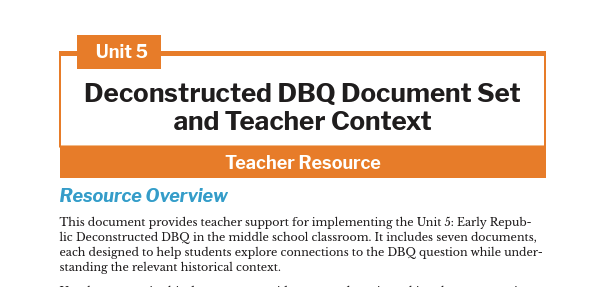Unit 5: Early Republic Model Organizer and Scoring Guide Teacher Resource

Resource Overview
This document is designed to help teachers support and assess students as they complete the unit’s deconstructed DBQ organizer. It breaks down each section of the organizer and provides model responses and examples to guide instruction.
Pair this resource with the Teacher Resource document for additional background on each primary source in the DBQ set. For guidance on teaching the necessary skills, refer to the mini-lesson slide deck.
| Groups: Answers will vary. A sample answer is provided.
Example: Group 1: Federalist Vision: Strong National Government
Group 2: Democratic-Republican Vision: State Powers and Limited Government
|
| Context: Answers will vary. Sample responses are provided.
Examples: Document A: Excerpt from Article I, Section 8 of the Constitution (1787)
Document B: Excerpt from Federalist #10 (James Madison, 1787)
Document C: Excerpt from George Washington’s First Inaugural Address (1789)
Document D: Excerpt from Alexander Hamilton’s Opinion on the National Bank (1791)
Document E: Excerpt from Thomas Jefferson’s Opinion on the National Bank (1791)
Document F: Excerpt from George Washington’s Farewell Address (1796)
Document G: Excerpt from the Sedition Act (1798)
|
| Context Summary: Answers will vary. Sample responses are provided.
Examples:
|
| “VIEW”ing the Documents: Answers will vary. Sample responses are provided.
Examples: Document A: Excerpt from Article I, Section 8 of the Constitution (1787)
Document B: Excerpt from Federalist #10 (James Madison, 1787)
Document C: Excerpt from George Washington’s First Inaugural Address (1789)
Document D: Excerpt from Alexander Hamilton’s Opinion on the National Bank (1791)
Document E: Excerpt from Thomas Jefferson’s Opinion on the National Bank (1791)
Document F: Excerpt from George Washington’s Farewell Address (1796)
Document G: Excerpt from the Sedition Act (1798)
|
| Question: How did the Constitution influence decisions in the Early Republic? |
| Thesis: Answers will vary. Sample responses are provided.
Examples:
|
Scoring Guides
1-point Rubric
| Evidence of Proficiency | Suggestions for Improvement | |
| Claim
Clearly and directly answers the question with a strong, defensible claim. |
||
| Line of Reasoning
Provides a clear, logical structure that outlines key points. |
||
| Document Analysis
Clearly identifies the author, purpose, historical context, and audience for at least three documents. Provides insightful analysis of the document’s significance. |
||
| Context
Provides accurate and appropriate historical context that explains the significance of the source and relates it to that time period. |
||
| Document Grouping
Groups documents in a thoughtful and effective way that strengthens the argument. |
||
| Use of Evidence
Effectively integrates relevant evidence from documents to support the claim. |
||
| Clarity & Organization
Thesis is clearly written, well-organized, and easy to understand. |
||
| Mechanics & Grammar
Free of errors in grammar, spelling, and punctuation. |
Scoring Matrix
| Criteria | 4 – Advanced | 3 – Proficient | 2 – Developing | 1 – Beginning |
| Claim | Clearly and directly answers the question with a strong, defensible claim. | Answers the question with a defensible claim. | Partially addresses the question with a weak or unclear claim. | Does not address the question or lacks a claim. |
| Line of Reasoning | Provides a clear, logical structure that outlines key points. | Establishes a reasonable line of reasoning with some organization. | Attempts a line of reasoning but lacks clarity or coherence. | Does not establish a logical line of reasoning. |
| Document Analysis | Clearly identifies the author, purpose, historical context, and audience for at least three documents. Provides insightful analysis of the document’s significance. | Identifies the author, purpose, context, and audience for at least three documents, but some explanations may lack depth. | Attempts to analyze three documents but misses key aspects of VIEW (e.g., unclear context or purpose). | Provides minimal or incorrect analysis of the documents. Missing multiple components of VIEW. |
| Context | Provides accurate and appropriate historical context that explains the significance of the source and relates it to the time period. | Context provided is mostly clear and accurate, but may lack depth or connection to the thesis. | Context attempts to explain significance and connection to time period but are unclear, too general, or contain inaccuracies. | Context is confusing, missing, or incorrect, showing little understanding of the documents and time period. |
| Document Grouping | Groups documents in a thoughtful and effective way that strengthens the argument. | Groups documents in a logical way that supports the argument | Groups documents, but the connections may be weak or unclear. | Does not group documents or groups them in a way that does not support the argument. |
| Use of Evidence | Effectively integrates relevant evidence from documents to support the claim. | Uses relevant evidence to support the claim. | Uses limited or somewhat relevant evidence. | Does not use evidence or evidence is unrelated. |
| Clarity & Organization | Thesis is clearly written, well-organized, and easy to understand. | Thesis is organized and mostly clear. | Thesis lacks clarity or has organizational issues. | Thesis is unclear and lacks organization. |
| Mechanics & Grammar | Free of errors in grammar, spelling, and punctuation. | Minor errors that do not interfere with meaning. | Noticeable errors that may distract from meaning. | Frequent errors that make the thesis difficult to understand. |
Total Score: ____ / 32
Comments: